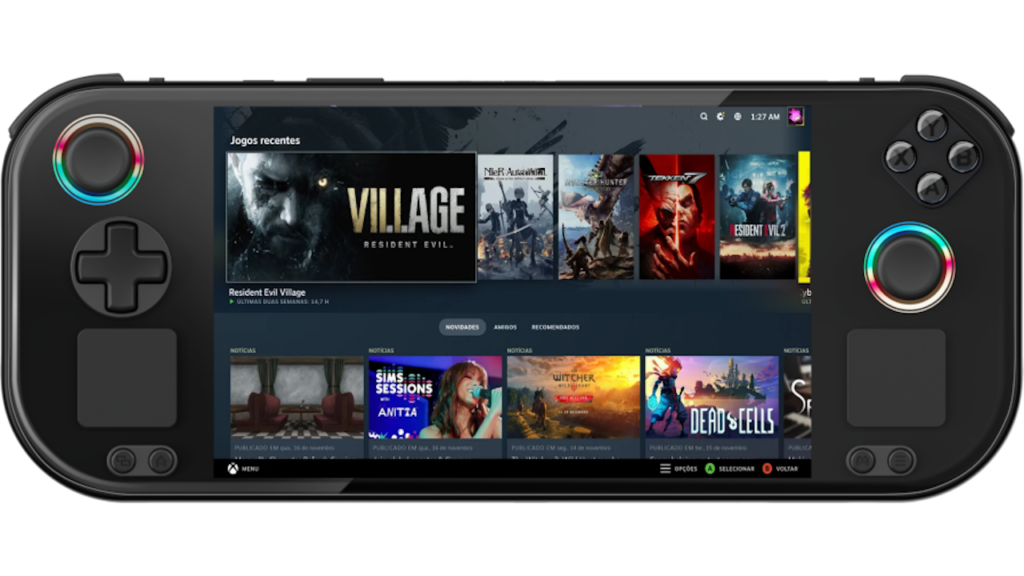We’ve heard rumblings about the device for quite some time now, but we’re finally getting a better look at the actual Orange Pi Neo itself, as well as detailed specifications for it.

As you can see from the image, the Orange Pi Neo takes some cues from other popular handhelds on the market, but let’s break this down into sections and analyze this new Linux handheld.
Straight off the bat, the Orange Pi Neo treats us to dual touchpads here, with gesture support. Steam Deck lovers will rejoice at this neat addition. Beyond that, we have a standard affair, 2 thumbsticks, a d-pad, face buttons, triggers and shoulder buttons, and dual 6-axis gyroscopes.
We also have 4 buttons along the bottom, which appear to be View, Menu, Home, and potentially Context Menu buttons. If it’s anything like the AYANEO setup though, one may be designed to display the desktop, one for an overlay for TDP management, etc., and the other 2 for your standard Start/Select on a gamepad.
There are LC and RC buttons on the top of the device, which can be custom-mapped to Macros or other buttons.

The display is a 7″ 1920×1200 16:10 panel. Capable of reaching up to 500 nits in brightness and a refresh rate of up to 120Hz. If it reaches these specifications, it should be a fairly bright screen with a clear image that’s ideal for gaming. It also has a bezel-less design, with the screen reaching the top and bottom of the device.

The Orange Pi Neo should pack a punch. It has an AMD Ryzen 7 7840U inside, which should put it in a similar league to the likes of the ROG Ally and Lenovo Legion Go, as well as the latest AYANEO offerings. It’s pretty much the flagship APU to use in handhelds right now, so it’s not surprising to see it being used here.
It will ship with either 16 or 32GB of 6400MHz LPDDR5 RAM. And a PCIe 4.0 M.2 (2280) NVMe between 512GB-2TB in size.
Powering it all is a 50Whrs battery, which is pretty beefy and should keep the device powered for a decent amount of time. For comparison, the ROG Ally has a 40Whrs battery.
The speakers are 2 1W downward-firing speakers on the bottom of the device.

In terms of ports and Input/Output we have the following:
The Orange Pi Neo uses a modified version of Manjaro Linux. Dubbed ‘Manjaro Gaming Edition’. This edition of Manjaro is aimed at offering a streamlined experience for users and optimizing the system for gaming. An emphasis has been placed on Flatpaks, offering an easy way to expand your software library.
When choosing hardware for the Orange Pi Neo, the team specifically chose hardware that had good compatibility with Linux, so there should be no worries regarding driver and software support for your device.

Manjaro Gaming Edition will also integrate with the SteamUI, allowing you to keep your device up-to-date with the latest software updates and security patches through the SteamUI. If you’re a Linux user or own a Steam Deck, you’re likely familiar with the “Discover” store too, which will be present on the device, giving you access to easy installations of popular applications.
As for the launch date, the team says they are aiming to launch in Q2 2024, so anytime between April and June 2024. The pricing is also just a range right now, with the team saying they hope to hit a price towards the lower end of the Steam Deck range. This would likely put it in the $400-$500 range, which seems ambitious for a 7840U handheld, but we hope they can achieve it.
What do you think? Is a powerful Linux handheld targeting a cheaper price point than its Windows competitors exactly what we need? Let us know in the comments below!
Sources for this article: Orange Pi Neo Q&A, Orange Pi Neo Website
If you enjoyed this article, check out the rest of the content on HandheldHQ! We have a wide variety of reviews and news that are sure to help your gaming experience. Whether you’re looking for news and handheld reviews, or just want to stay up-to-date on the latest trends, we’ve got your back.
Honestly I don’t get why you would need 2 USB 4 on such a device.
Wouldn’t a USB C wired for 2.0 speeds or charging be better, since It would made the manufacturing process simpler and cheaper?
Especially considering that this device is targeting Steam Deck prices.